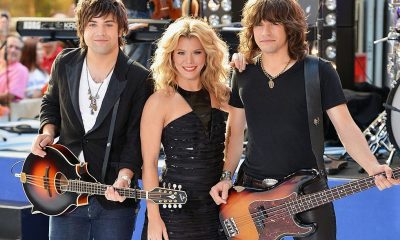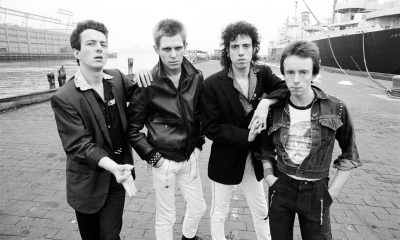Columns
The Noise Beneath The Apple: Where The Sky Kisses The Dirt
Matt Turk grew up in Armonk, New York, on the Hudson River near his grandparents; before the airport arrived, before IBM landed, and where Smith’s Tavern—a historical landmark of the Revolutionary War—still stands.
Sitting across from him at Coogan’s, on the UWS, I am enchanted by his sincere voice and the memories that dance across his face.
He remembers a lot of things; the stories passed down through his family, humid evenings in Westchester County and days as a busker in the now-diminishing public spaces of New York City.
A graduate of NYU, he studied history and religious studies. Shakespeare, music, art, the Greek classics. He always knew he was going to be a musician, but wanted (and acquired) a liberal arts education. Turk has been reviewed in such publications as the New York Times and Rolling Stone, publications that have called him things like “extraordinarily talented, introspective and folksy,” and “a troubadour of heartfelt rock & roll.”
Over twenty years ago, Turk co-founded a band called The Hours, which opened about a dozen shows for the then-unknown Dave Matthews, and his music has appeared on countless television programs. He’s worked with the likes of Phil Ramone and Pete Seeger.
Still, he busks in the New York subways “on and off,” and has done so since he was 17 years old. “I’m always looking for refreshing contexts to make music. And it [the subway] was refreshing and exciting and spontaneous and just really about the experience and about the moment and not about anything else.”
And it is this context—creating and presenting music in a public space—that faces extinction on a daily basis…in the world at large, in the United States, and especially in New York City. The genocide of public space and the impact it has on society is a recurring theme amongst subway buskers and street performers.
But why is public space such an important commodity? Why should we as a society struggle to preserve it?
Howard Besser, Associate Professor of UCLA School of Education and Information (a place where you have to publish or perish), addresses this issue at length. His research clearly connects the decrease in public space with the increase in crime rates throughout many cities in the world. He examines the psychological and calming effect on people in cities as they board trains listening to a soulful singer/songwriter versus the blaring intercom overhead.
And then there’s the more esoteric concept of preserving culture and tradition, the ability to exchange ideas in a free environment, free speech, First Amendment Rights…
In recent times, there has been a flurry of questions inspired by the disappearance of public space. Who decides the appropriate use of public space? Who defines what legitimate culture is? These questions are explored in such works as Mike Davis’s City of Quartz, Michael Sorkin’s Variations on a Theme Park: Scenes from the New American City & The End of Public Space and Sharon Zukin’s The Cultures of Cities.
And although I am not a scholar, I remember, as a kid, how we gathered around a campfire and told stories. We would try and scare the younger ones. We would make up a past or a future, pass tales along, talk about water rights or land rights, where the first road would probably be built and “who the heck was that naked hippie guy in the sweat lodge?” It was a place where everyone was free to express all these things and more. It was public space. The idea that it would not exist was foreign to me.
In the mainstream world, a world that is not the Indian land where I grew up, the government systematically regulates and exerts control over public spaces and the people who congregate there. In turn, both the peoples and the places disappear.
Specifically in New York City, media, Law Enforcement and various agencies cite 9/11 as the impetus for increased governmental control in public spaces. However, was there ever a more appropriate time than in the wake of September 11th for a space where people could gather without fear and heal as a community?
“Living in New York during 9/11 was really rough,” Matt Turk recalls. “And going to war right away in Iraq was really rough. And ten years later, it’s a mess. I remember after 9/11, we got a permit [because public space was already being regulated for the previous 30 years] for Union Square and we just set up and we played. Everyone was really hurting and it was free and there were just so many people and the experience transcended all the limitations and boundaries.”
It was a time that New York City really needed a campfire, like we had back then on Indian land.
Turk’s 2008 collaboration with Pete Seeger, “The Fog of War,” makes a very simple observation; everyone loses in the fog of war.
Today, it is required to have a MUNY licence banner to perform on the subway platforms in New York City, a public space where, technically and legally speaking (according to the First Amendment), no such banner—no such flag—needs to wave.
“I feel the reason the subway worked is that we were able to play music that touched the same sentiment that was in everyone’s heart, which is this: Doesn’t it suck that the people who put their lives on the line and struggle the most get the least amount of compassion? And here we are singing songs that were about that…that were about veterans, that were about social justice. And random strangers were responding to it in a very heartfelt way. That was a big part of it. We weren’t playing pop songs down there. We weren’t playing covers. It was about the uselessness of the cycles of violence and the perpetuation of megalomania and tyranny. We were just trying to get it back to the people. We had an audience there that was raw and that’s why we were into it. We were singing, “We Shall Overcome,” and it wasn’t about overcoming civil rights issues that were relevant 45 years ago, it was about issues having to do with corporate welfare that the government was promoting and selling out the American dream and destroying the populous today.”
Matt Turk grew up on Pete Seeger’s music. Pete was big. His message was bigger. He riled a lot of people up and became revered by even more. His was a message of social justice and all its many layers of personal responsibility. It is a message that is woven like fine thread throughout Matt’s music.
“Social justice isn’t about being right; it’s about helping other people. I think there are no limits [to] how much we can reach out [and] try to help other people,” says Matt.
These words are the rudder that guides his life, from his four year residency at a homeless shelter in White Plains to delivering food to homebound people with HIV, to his free performances in the parks, subways and remaining public spaces in New York City.
“Being able to articulate why that context is so relevant for storytelling and singing is the soul piece and I think part of it has to do with money,” Matt explains. “When you go see Pop Star #1 at Venue #1, you need to have a certain amount of money to buy the ticket to get in. It’s still money that brings people together. The subway has nothing to do with that. The subway is just people who are getting around. It’s pretty incredible how souls connect in these moments of freedom that have no financial context, and it makes a difference. Free shows create something truly wondrous that ticketed events don’t. And that’s the measure that is really the equalizer.”
Public space is, by nature, a place where all people can converge without economic or social exclusion. Conversely, a private space is an area where admittance is determined by one person or a small group of people. Since the 60s, New York has given birth to a host of zoning laws which create ‘privately owned public space’. According to the New York City Department of City Planning, and the Municipal Art Society of New York, many of these areas are buildings, plazas, streets and walkways…but have now grown to include parts of Battery Park and the East River Waterfront. A few of the private owners of this brand of public space are Goldman Sachs and JP Morgan—developers who received incentives from the city.
“Financial context influences everything. It influences music and culture, and I think people need to be honest about that. In my experience as a busker, money affects everything. And the lack of money also affects everything. People connect in public spaces, in a way they cannot anywhere else,” explains Turk. “I’ve had a lot of experiences of meeting people that are really transcendent. There’s a woman at the 125th stop who was in some Alabama march and now she’s just going home. She stops and sings and tells us something about her life. Busking is a real equalizer about what’s true about humanity, without all the affectations. You can experience something real, with a capital “R,” and what makes it real is the separation from all those other things. We have a mayor in New York City who takes the subway, and he’s a billionaire mayor, and you’re presenting music for him, no different than a middle class person who is sweating for their job.”
Today, Turk’s goal is a simple one. “To write songs that become part of the campfire culture, songs that kids sing when they’re just sitting around.” For him, such artists were James Taylor, acoustic Zep and, “the Beatles, of course.”
Growing up on Indian land, space was not an issue for me. We had lots of it, and I believed it was in no danger of going anywhere. Where were the mountains going to run? Where was the river going to hide?
One day, I asked Chief Sconchian; “Where does my land stop?”
He looked out over the endless earth that he had borrowed from his ancestors and replied. “Do you see where the sky kisses the dirt?”
“Yes.”
“That is as far as you can go.”
Chief was the last full blooded Modoc Indian. Once he was gone, there would be no more.
Forever.
And as I look at the grime and grit-laced walls—decorated with graffiti marked tiles, worn and tattered movie posters, advertisements for cheap dental care and models with blackened teeth—I wonder how Chief would answer that same question today. Because like Chief, once it is gone—there will be no more.
Forever.
- Lists13 years ago
Top 10 Country Music Albums of 2010

 Interviews5 years ago
Interviews5 years agoJohn Rich – The Interview

 Song Reviews16 years ago
Song Reviews16 years agoTaylor Swift – “Love Story”

 Interviews5 years ago
Interviews5 years agoHoneyhoney on Hiatus: Revisit our 2008 Interview with Suzanne Santo

 Album Reviews14 years ago
Album Reviews14 years agoAlbum Review: Miley Cyrus – Can’t Be Tamed

 Song Reviews6 years ago
Song Reviews6 years agoThe Band Perry – “Hip To My Heart”

 Columns5 years ago
Columns5 years agoThe Link Between Folk Music’s Past and Present

 Columns5 years ago
Columns5 years agoIs Marketing Killing Rock and Roll?

